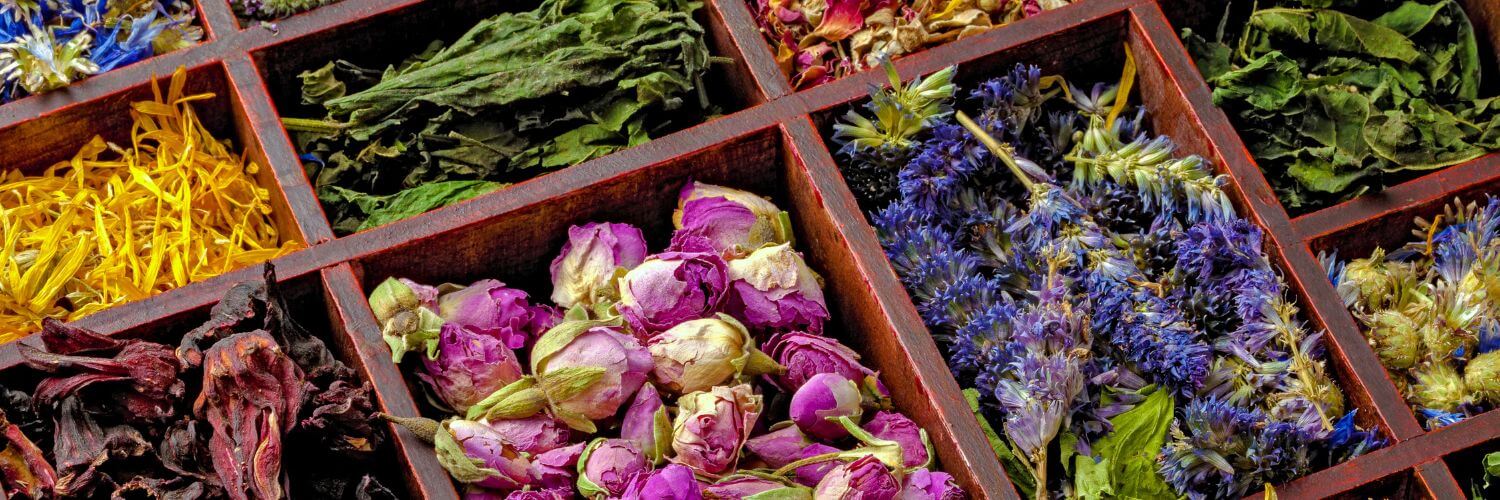制作自己的花草茶
家庭制作花草茶的入门指南
几个世纪以来,草药茶因其舒缓特性和健康益处而受到不同文化的珍视。无论您是在漫长的一天后想放松一下,还是寻求治疗常见疾病的自然疗法,草药茶都能为您提供愉悦的治疗体验。
概述

在本指南中,我们将探索在家制作自己的草药茶所需的一切知识。从了解草药茶的基础知识、选择和混合草药,到掌握冲泡艺术,我们都能满足您的要求。读完本文后,您将拥有足够的知识和信心来制作符合您口味和健康需求的个性化草药茶混合物。
1. 了解花草茶
定义和好处
草本茶,又称药草茶,是一种将草药、香料、水果和其他植物材料在热水中浸泡或煎煮而成的饮料。与传统茶(红茶、绿茶、白茶)不同,草本茶不含茶树植物的茶叶,这意味着它们天然不含咖啡因。对于那些寻求舒缓和不含咖啡因的饮料的人来说,草本茶是绝佳的选择。
草药茶的健康益处
草本茶因其广泛的健康益处而受到赞誉,具体益处取决于所用的草本。一些常见的益处包括:
- 消化健康:众所周知,薄荷茶和姜茶等有助于消化和缓解胃部不适。
- 放松和睡眠:洋甘菊和薰衣草茶因其镇静作用而广受欢迎,有助于促进放松并改善睡眠质量。
- 免疫支持:紫锥菊和接骨木等草药经常用于茶中,以增强免疫系统并抵御感冒和流感。
受欢迎的茶用草药
选择合适的草药对于制作美味且有益的草药茶至关重要。以下是草药茶中常用的一些流行草药:
- 洋甘菊:洋甘菊茶以其镇静作用而闻名,非常适合放松和助眠。 购买洋甘菊
- 薄荷:薄荷茶味道清新,有助于消化,舒缓胃部。 购买薄荷
- 芙蓉:芙蓉茶是一种酸味浓郁的草本植物,富含抗氧化剂,有益于心血管健康。 购买芙蓉
- 姜:姜茶辛辣温热,对消化和增强免疫系统有极好的帮助。 购买姜
- 薰衣草:这种芳香的草本植物有助于放松,有助于缓解压力和焦虑。 购买薰衣草
制作凉茶的必备工具
基本设备
要泡出一杯完美的花草茶,拥有合适的工具至关重要。以下是您需要的一些基本设备:
- 茶壶:泡花草茶时,一把优质的茶壶必不可少。陶瓷、玻璃或铸铁茶壶是受欢迎的选择,因为它们保温性好,而且容易清洗。
- 浸泡器:浸泡器用于在热水中浸泡散装药草。浸泡器有很多种,包括网状球、硅胶浸泡器和篮式浸泡器。
- 水壶:一个好的水壶对于将水加热到合适的温度是必不可少的。具有温度控制功能的电水壶对于确保水适合不同类型的草药尤其有用。
可选配件

虽然基本工具可以帮助您入门,但一些可选配件可以增强您的草药茶制作体验:
- 温度计:确保水温适宜会对茶的口感产生重大影响。温度计可以帮助您泡出完美的茶。
- 茶滤:如果您喜欢直接在茶壶中冲泡散装草药,则茶滤将有助于倒茶,而不会让草药进入杯中。
- 储藏罐:妥善储藏对于保持草药的新鲜度和药效至关重要。密封玻璃罐是保持草药干燥、避免光照和潮湿的理想选择。
建议
为了获得最佳效果,投资高质量的工具可以增强草药茶的风味和健康益处。以下是一些建议:
- 陶瓷茶壶:保温性好,易于清洁。
- 不锈钢网状浸泡器:耐用且足够精细,可防止细小的草本颗粒逸出。
- 带温度控制的电热水壶:确保您可以将水加热到适合不同草药的温度。
- 带密封盖的玻璃储物罐:让您的香草保持新鲜和美味。
拥有合适的工具可以让您制作和享用自己的凉茶的过程成为一种愉快而令人满意的体验。
在家调配花草茶
选择你的药草
制作自己的草药茶混合物可让您根据自己的喜好和需求定制口味和健康益处。以下是选择最佳草药的一些技巧:
- 风味特征:考虑您喜欢的风味。有些草药具有强烈而独特的味道,而其他草药则更微妙。混合互补的风味可以创造出均衡的混合物。
- 健康益处:根据健康益处选择草药。例如,洋甘菊有利于放松,而姜有助于消化。
- 品质:始终使用高品质的有机草药,以确保最佳风味和健康益处。
混合技术
混合草药茶既是一门艺术,也是一门科学。以下是一些帮助您制作美味而有效的混合茶的技巧:
- 口味平衡:首先从一种基本药草开始,该药草占混合物的 50-70%。添加次要药草来补充基本药草,最后加入少量的重点药草以增加风味或增加健康益处。
- 比例:典型的混合物可能是 2 份基本药草、1 份次要药草和 0.5 份重点药草。根据口味调整比例。
- 实验:不要害怕尝试不同的组合。记录您的混合情况,记住哪种效果最好。
定制提示
以下是一些根据您的口味和健康需求定制花草茶混合物的技巧:
- 增味剂:添加干果、柑橘皮或香料(例如肉桂、小豆蔻)等成分来增强风味。
- 健康重点:定制您的混合物以解决特定的健康问题。例如,混合薄荷和生姜以促进消化健康,或混合洋甘菊和薰衣草以放松身心。
- 甜味剂:如果您喜欢甜茶,可以考虑添加天然甜味剂,如蜂蜜、甜菊糖或甘草根。
混合示例
以下是一些可供您入门的示例混合物:
请记住,调制自己的草本茶混合物的乐趣在于能够尝试并发现您最喜欢的组合。不断调整和品尝,直到找到完美的组合。
冲泡花草茶
冲泡基础
泡制花草茶是一门艺术,需要正确的技巧才能从草药中提取出最佳风味和健康益处。以下是泡制一杯完美花草茶的一些基本技巧:
- 水质:使用过滤水可获得最佳口感。自来水中可能含有会影响茶味道的杂质。
- 水温:与传统茶不同,大多数草药茶需要沸水(约 212°F 或 100°C)。但是,一些娇嫩的草药可能需要稍凉的水以避免苦味。
- 浸泡时间:草药茶通常需要比传统茶更长的浸泡时间。浸泡草药至少 5-10 分钟,以确保最大程度地发挥其风味和功效。
一步步冲泡指南
按照以下步骤泡一杯美味的花草茶:
- 测量草药用量:每杯水加入约 1-2 茶匙干草药。根据您的口味偏好和草药浓度调整用量。
- 烧开水:将水加热至沸腾。如果您使用带温控的水壶,请将温度设置为 212°F (100°C)。
- 准备泡茶器:将量好的草药放入泡茶器中,或者如果您打算稍后过滤茶,则直接放入茶壶中。
- 加水:将沸水倒入泡茶器或茶壶中的草药中。
- 泡茶:盖上盖子,让茶浸泡 5-10 分钟。有些草药可能需要较长时间浸泡;根据您使用的具体草药进行调整。
- 过滤并饮用:如果您直接在茶壶中冲泡茶,请在饮用前过滤草药。否则,请取下茶壶。将茶倒入杯中即可享用。
泡出完美茶饮的秘诀
为了确保您总能泡出一杯完美的花草茶,请牢记以下提示:
- 尝试不同的浸泡时间:不同的药草可能需要不同的浸泡时间才能发挥出最佳风味。从建议的时间开始,然后根据您的口味进行调整。
- 使用新鲜药草:新鲜是制作美味且有益的茶的关键。确保您的药草妥善储存并在保质期内使用。
- 避免浸泡过度:虽然浸泡时间较长可以增强风味,但浸泡过度有时会导致苦味,尤其是对于娇嫩的香草而言。
提升你的茶
为了进一步提升您的茶的品质,请考虑添加:
- 甜味剂:蜂蜜、甜菊糖或龙舌兰糖浆可以增添一丝甜味。
- 柑橘:一片柠檬或橙子可以增添味道。
- 香料:肉桂、小豆蔻或丁香可以给您的茶增添温暖和复杂性。
通过遵循这些指导方针并尝试不同的技术,您将能够冲泡不仅美味而且富含健康益处的草本茶。
草药茶食谱
自己制作混合草药茶既有趣又有益。以下是一些简单和高级的配方,可帮助您入门:
适合初学者的简单食谱
这些易于制作的混合物仅需要几种原料,非常适合初学者。
镇静甘菊茶
清爽薄荷茶
高级家庭茶饮配方
对于那些想要尝试更复杂口味的人来说,这些先进的配方提供了更丰富、更细致入微的茶体验。
增强免疫力混合物
香料姜茶
- 2茶匙姜
- 1 茶匙肉桂皮(未提供肉桂链接)
- 0.5 茶匙丁香(未提供丁香链接)
- 浸泡10至12分钟。
特色茶
这些食谱针对特定的健康益处,非常适合纳入您的保健常规中。
消化舒适茶
放松睡眠茶
通过尝试这些食谱并根据您的口味进行调整,您将能够根据您的喜好和需求制作出美味又有益的凉茶。
储存和保存草药茶
正确储存草药茶对于保持其新鲜度、风味和效力至关重要。以下是一些确保草药保持最佳状态的指南。
储存技巧
密封容器:将干草药存放在密封容器中,防止其暴露在空气中,否则会降低其质量。密封玻璃罐是理想的选择。
阴凉处:将药草存放在阴凉处,远离阳光直射和高温。光线和高温会导致药草失去其味道和药用价值。
干燥环境:确保储存区域干燥。潮湿会导致发霉和变质。考虑在容器中添加一包硅胶以吸收多余的水分。
贴标签:在容器上贴上药草名称和储存日期的标签。这将帮助您跟踪药草的新鲜度,并确保您首先使用最老的药草。
保质期
干草药的保质期各不相同,但一般来说,如果储存得当,它们的药效可以保持 6 个月到一年。以下是一些一般准则:
- 叶类草本植物(例如薄荷、洋甘菊) :这些草本植物通常可以保持新鲜长达一年。
- 根和树皮(例如生姜、肉桂) :这些具有较长的保质期,并且可以保持新鲜长达两年。
- 花朵(例如薰衣草、芙蓉花) :这些花朵比较娇嫩,应在 6 个月至一年内使用。
保持新鲜度的秘诀
- 定期检查:定期检查储存的草药是否有变质迹象,例如颜色、气味的变化或出现霉菌。
- 小批量:如果可能的话,请小批量购买或干燥草药,以确保在它们仍然新鲜时使用。
- 按需研磨:为了发挥最大功效,请将草药整株保存,并在使用前研磨。这有助于保留其精油和风味。
让陈腐的药草恢复活力
如果您的草药已经失去了部分效力但仍然可以安全使用,您可以稍微恢复它们的效果:
- 热激活:将草药放在干锅中轻轻烘烤几分钟,以释放其精油。小心不要烧焦它们。
- 蒸制提神:将药草放在滤锅中,放在一锅蒸水上,蒸几秒钟。这可以帮助恢复其香气和味道。
通过遵循这些存储和保存技巧,您可以确保您的凉茶尽可能长时间保持新鲜、美味和有效。
常见问题 (FAQ)
制作和享用花草茶可能会引发许多问题。以下是一些常见问题及其答案,可帮助您踏上花草茶之旅。
常见问题
草本茶与传统茶有何不同?
- 草本茶,又称药草茶,由多种植物材料制成,包括草药、香料、鲜花和水果,而传统茶(红茶、绿茶、白茶)则由茶树植物的叶子制成。与传统茶不同,草本茶天然不含咖啡因。
我怎么知道该用哪种草药来泡茶?
- 根据你的口味偏好和想要的健康益处选择草药。例如,洋甘菊和薰衣草有助于放松,而薄荷和生姜有助于消化。尝试不同的组合,找到你最喜欢的。
我可以用新鲜药草代替干药草吗?
- 是的,你可以使用新鲜药草。但是,你需要使用比干药草更多的新鲜药草,因为干药草的浓度更高。通常,新鲜药草的用量是干药草的三倍。
我应该将凉茶泡多长时间?
- 大多数草药茶应浸泡 5-10 分钟。有些根和树皮可能需要更长的浸泡时间,长达 15-20 分钟。根据具体草药和您的口味偏好进行调整。
我可以将不同的草药混合在一起吗?
- 当然可以!混合不同的草药可以产生独特的风味并增强健康益处。只需确保平衡风味并考虑每种草药的特性即可。
我应该如何储存我的凉茶?
- 将干草药存放在密封容器中,放在阴凉、干燥的地方。正确的储存方式可确保草药尽可能长时间保持新鲜和药效。
有哪些草药是我应该避免的?
- 虽然许多草药都是安全的,但有些草药可能会产生强烈作用或与药物产生相互作用。在使用不熟悉的草药之前,请务必进行研究或咨询医疗保健提供者,尤其是当您有健康问题或怀孕时。
有哪些常见的草药茶配方具有特定的健康益处?
- 放松和睡眠:洋甘菊、薰衣草和柠檬香蜂草。
- 助消化:薄荷、生姜和茴香。
- 增强免疫力:紫锥菊、接骨木和玫瑰果。
我可以给我的凉茶加糖吗?
- 是的,你可以用天然甜味剂(如蜂蜜、甜菊糖或龙舌兰糖浆)来增加花草茶的甜味。根据你的口味调整用量。
制作凉茶需要什么设备?
- 基本设备包括茶壶、泡茶器和水壶。温度计和茶滤等可选配件可以提升您的泡茶体验。
其他提示
- 实验:不要害怕尝试新的草药和混合物。记下最适合您的草药。
- 保持知情:了解不同草药的特性和好处,以便做出明智的选择。
- 享受过程:泡茶和喝茶是一种放松和享受的仪式。花些时间欣赏茶的味道和香气。
这些常见问题解答应该可以帮助您入门并自信地制作和享用自己的凉茶。
要点总结
在家制作自己的花草茶是一个有益而愉快的过程,您可以根据自己的喜好定制口味和健康益处。以下是我们所涵盖内容的简要回顾:
- 了解草本茶:草本茶由多种植物材料制成,具有多种健康益处,但不含传统茶中的咖啡因。
- 必备工具:购买优质茶壶、泡茶器和水壶。温度计和储水罐等可选配件可以提升您的泡茶体验。
- 混合草药茶:根据口味和健康益处选择草药,并使用混合技术来创造均衡有效的茶混合物。
- 冲泡花草茶:遵循基本的冲泡指南来冲泡一杯完美的茶,并使用技巧来增强茶的味道和效力。
- 草本茶食谱:尝试简单和高级的食谱来找到您最喜欢的混合茶。
- 储存和保存:正确储存可确保您的草药保持新鲜和有效。遵循我们的提示来保持草药茶的品质。
- 常见问题解答:解答常见问题可以帮助您对泡茶之旅更加有信心。
制作草药茶的艺术是科学与创造力的完美结合。不要害怕尝试不同的草药和配方。练习得越多,你就越能发现什么最适合你的口味和健康需求。
我们鼓励您今天就开始您的草本茶之旅。访问我们的产品页面,购买高品质的有机草本茶,并开始制作您的个性化混合茶。在下方评论中或在我们的社交媒体频道上与我们分享您的经验和食谱。
如需了解更多信息并了解我们种类繁多的草药,请访问我们的网站: Sacred Plant Co 。
其他资源
产品推荐
我们希望本指南能激发您探索草本茶的奇妙世界。享受这个过程以及随之而来的诸多好处!





